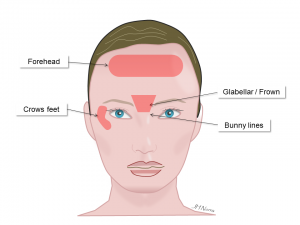Botulinum toxin is a muscle relaxant that has been used for many years for the cosmetic treatment of wrinkles. The two main types are Botox® and Dysport®. It also has other uses such as in facial palsy, corneal exposure and certain types of squint.
Botulinum toxin is most often used to treat the upper face including the forehead lines and frown lines (glabella region) in the lower central forehead and bunny lines on the nose. It can be used around the eyes (pericoular region) to treat crows feet and lower eyelid wrinkles. In selected cases Botulinum toxin can be used to raise the eyebrow. The lower face can also be treated to improve lines around the mouth and chin where appropriate. (Tap to enlarge image).
Botox and Dysport are very similar. They are both FDA approved and are a type of botulinum type A used to relax the muscles with a good safety profile. Both types of treatment take 2-3 days to take effect and you normally need to repeat treatments every 3-4 months depending on your sensitivity.
Botulinum toxin is a neurotoxin that weakens the muscle in to which it is injected. It acts be blocking the communication between the nerve and the muscle.
Botulinum toxin is given as an injection in the clinic room using a very fine needle. Small volumes are injected beneath the skin to the specific muscles around the eye and face that need treatment. We often advise the use of ice packs after treatments to prevent bruising and minimise pain.
Mr Norris carries out all treatments personally providing a discrete and bespoke approach.
The side effects of Botox® or Dysport® are:
- You may develop some subtle redness around the area of the injection and occasionally some bruising which is quite common.
Rare complications include
- A squint with double vision
- Drooping of the face
- Drooping of the upper eyelid
- Blurred vision
Very rare complications include:
- An allergy to the treatment
- A change in your voice
- Loss of bladder control
- Difficulty swallowing
This type of treatment does not have long term follow-up over decades and we do not know the long term impact if using Botulinum Toxin over many years.
Please note: This list does not include all the possible complications of using botulinum toxin.
Please refer to the emergency contact page (under the header ‘Contact’) if you need advice or have a problem.
Author: Mr Jonathan Norris FRCOphth

